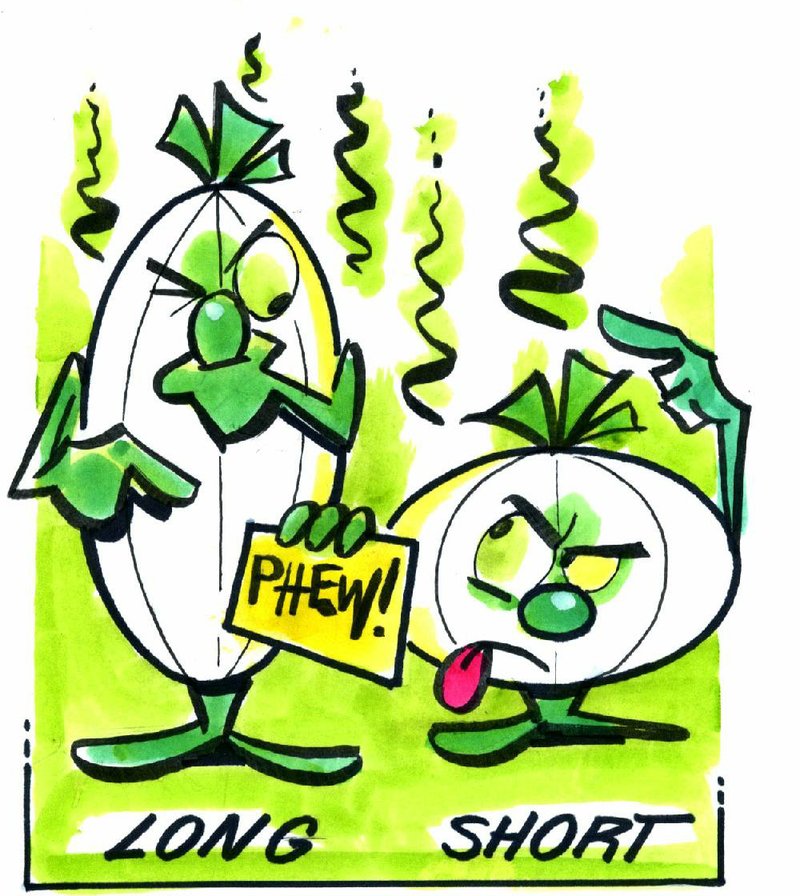Q What are the differ-ences between long-day onions and short-day onions? Which type grows best in our area, and how soon can I plant some?
A Onions are classified as either short-day or long-day onions by the amount of time or day length required to trigger bulb formation. Long-day cultivars need 14 to 16 hours of sunlight per day to initiate bulb formation, while short-day onions trigger at 12 hours. Usually, long-day onions are relegated to the North, since temperatures start getting too high as the day lengthens in the South. Long-day onions will grow in the South, but they won't make the best bulbs. Short-day onions are a better bet for the South because they have time to produce a bulb before it gets too hot. If you are growing for green onions, either would work. If you want large onion bulbs, opt for the short-day varieties. Transplants are bought in bundles (usually 60 to 80 plants) from garden centers. Transplanting is the most common way to plant short-day onions. Onion transplants should start arriving in nurseries and garden centers soon. As soon as you find them, you can start planting.
Q Last year I planted wildflowers along the back of my property. For the first year they did OK, and while I had some blooms I had a lot more weeds and grass. Could I spray weed killer that's OK for a regular flower garden on a wildflower garden?
A There are very few herbicides safe to kill broadleaf weeds in flowerbeds, since most flowers are broadleaf plants -- and that includes wildflowers. There are some pre-emergent products labeled for ornamentals, but we want wildflowers to grow from seed as well as the root system, so a pre-emergent would not be a good idea. Grass-specific herbicides can be used around wildflowers (Poast, Grass-b-gone, etc.). If grass is your main weed problem, try that this summer when the grass begins active growth. It won't work on broadleaf weeds nor dormant grass. Clean up the area as best you can now and try to keep it as clean as possible. This situation is why it is critical to do a good job of killing weeds before planting wildflower seed, since the mix isn't easy to deal with later.
Q We just built a new house, and there is no landscaping. I want to use azaleas for foundation plants. Our home faces west, and we have no shade at this time. In researching azaleas/rhododendrons I have found several varieties that suggest they prefer full sun. However, I've mostly been told that is a "no-no" around here, and that the afternoon sun will do them in. What are the differences between rhododendrons and azaleas? Could you suggest alternate plants if azaleas will not work for us?
A Azaleas are members of the rhododendron family, and closely related, but they are quite different in ease of care -- at least here in Arkansas. We do quite well with azaleas but struggle with rhododendrons. Rhododendrons should never be planted in full sun. They need morning sun and afternoon shade. For full sun, there are some of the repeat blooming azaleas such as Encore that can take full sun, but they will need ample water. I recommend establishing them in the spring, so they have all spring and summer to get a root system in place before winter. Think about the roller-coaster ride we had this past winter. In full sun such weather can make azaleas more susceptible to winter damage. Some other options for blooming shrubs in full sun include summer blooming spirea, althea or rose of Sharon, or Ninebark. Two that would do well in all but the northwestern part of Arkansas are Indian hawthorn and loropetalum.
Q I have had an oleander planted outside here in central Arkansas for two or three years. It has bloomed well in the summer, but it isn't growing as much as I would like. I brought it here from Florida. What should I do to encourage it to grow larger?
A Oleander was rarely winter-hardy in central Arkansas until the last 10 years or so. Our winters have become more mild, and even if a sharp bit of weather causes some die-back, plants bounce back. That being said, we are colder than Florida so they are not as vigorous in Arkansas as they are in Florida's longer growing season. They should respond to nitrogen fertilizer, which can be used in the spring when new growth begins. Apply fertilizer monthly during the growing season, but stop all applications by late August.
Janet B. Carson is a horticulture specialist for the University of Arkansas Cooperative Extension Service. Write to her at 2301 S. University Ave., Little Rock, Ark. 72204 or email her at
jcarson@arkansasonline.com
HomeStyle on 02/04/2017
